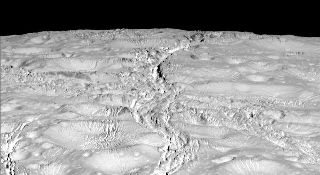Oct 19 2015
NASA's Cassini spacecraft has begun returning its best-ever views of the northern extremes of Saturn's icy, ocean-bearing moon Enceladus. The spacecraft obtained the images during its Oct. 14 flyby, passing 1,142 miles (1,839 kilometers) above the moon's surface. Mission controllers say the spacecraft will continue transmitting images and other data from the encounter for the next several days.
 NASA's Cassini spacecraft zoomed by Saturn's icy moon Enceladus on Oct. 14, 2015, capturing this stunning image of the moon's north pole. A companion view from the wide-angle camera (PIA20010) shows a zoomed out view of the same region for context. Image Credit: NASA/JPL-Caltech/Space Science Institute
NASA's Cassini spacecraft zoomed by Saturn's icy moon Enceladus on Oct. 14, 2015, capturing this stunning image of the moon's north pole. A companion view from the wide-angle camera (PIA20010) shows a zoomed out view of the same region for context. Image Credit: NASA/JPL-Caltech/Space Science Institute
Scientists expected the north polar region of Enceladus to be heavily cratered, based on low-resolution images from the Voyager mission, but the new high-resolution Cassini images show a landscape of stark contrasts. "The northern regions are crisscrossed by a spidery network of gossamer-thin cracks that slice through the craters," said Paul Helfenstein, a member of the Cassini imaging team at Cornell University, Ithaca, New York. "These thin cracks are ubiquitous on Enceladus, and now we see that they extend across the northern terrains as well."
Cassini's next encounter with Enceladus is planned for Oct. 28, when the spacecraft will come within 30 miles (49 kilometers) of the moon's south polar region. During the encounter, Cassini will make its deepest-ever dive through the moon's plume of icy spray, sampling the chemistry of the extraterrestrial ocean beneath the ice. Mission scientists are hopeful data from that flyby will provide evidence of how much hydrothermal activity is occurring in the moon's ocean, along with more detailed insights about the ocean's chemistry -- both of which relate to the potential habitability of Enceladus.
Cassini's final close Enceladus flyby will take place on Dec. 19, when the spacecraft will measure the amount of heat coming from the moon's interior. The flyby will be at an altitude of 3,106 miles (4,999 kilometers).
The Cassini-Huygens mission is a cooperative project of NASA, ESA (European Space Agency) and the Italian Space Agency. NASA's Jet Propulsion Laboratory in Pasadena, California, manages the mission for the agency's Science Mission Directorate in Washington. JPL is a division of the California Institute of Technology in Pasadena. The Cassini imaging operations center is based at the Space Science Institute in Boulder, Colorado.